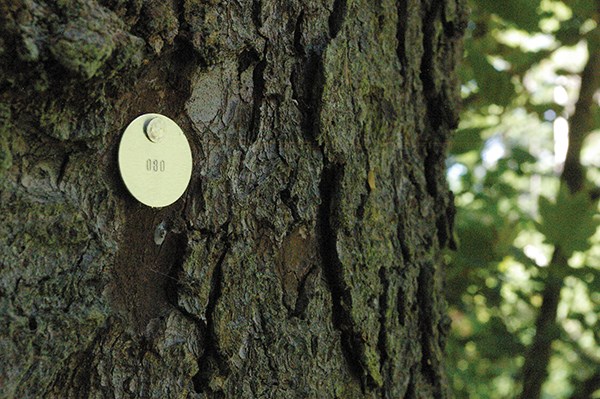Have you seen a tag on a tree while on a recent walk? Don’t despair, the little metal tags on some trunks aren’t a sign of future doom for the beloved trees. In fact, the tags represent hope for their future.
Squamish River Watershed Society volunteers are in the midst of tagging trees in the hopes of creating some baseline data, according to the society’s Edith Tobe.
Tall, older trees along the Loggers Lane trail, by the Squamish Adventure Centre and in the Squamish Estuary Wildlife Management Area around the downtown are the ones on which volunteers are focusing, according to Tobe, executive director of the society.
“What we are trying to do is tag them to identify the trees. We are GPS’ing them, putting in the location on a map and we will have them as an indicator so we can keep an eye on these trees in years to come and catalogue them,” Tobe explained. “To provide a database so we know what trees we have out there and how many mature trees we have.”
The trees are chosen by a rough estimate of their diameter at breast height, according to Tobe.
“Basically, if there are two of us on either side of the tree and our hands can’t touch,” she said, adding the majority of the tagged coniferous and deciduous trees are maple, cottonwood, cedar or Sitka spruce.
The Squamish Heritage Tree Project began last year with Quest University students identifying significant trees in the estuary, Tobe said. The society has carried on and expanded the work. A total of almost 200 trees have been tagged so far.
Information about each tree will be collected and put out on the society’s website. Ultimately, Tobe hopes to incorporate the information onto the District of Squamish’s environmentally sensitive habitat maps.
“We are making this work available to anybody who wants it,” she said, adding perhaps other groups would like to expand on the work done so far to other areas of Squamish.
“It is a great student project,” she noted. “I don’t know where this will lead to, but it is providing us a baseline for our mature trees.”
This work is routinely done in other places, Tobe said, such as in Vancouver’s Stanley Park and at the University of British Columbia Botanical Garden.
“This is just our first step of identifying these significant trees and wanting people to be aware that these are magnificent giants in our midst.”
For more on the project go to www.squamishwatershed.com, look under Projects and click Wildlife and Heritage trees.



